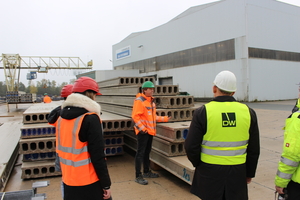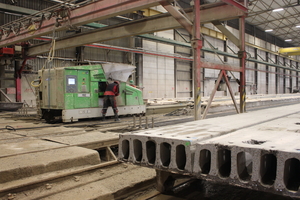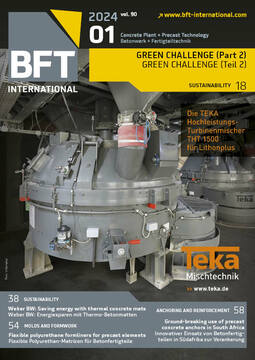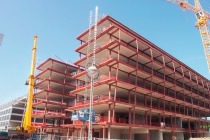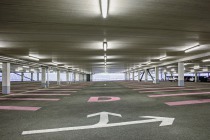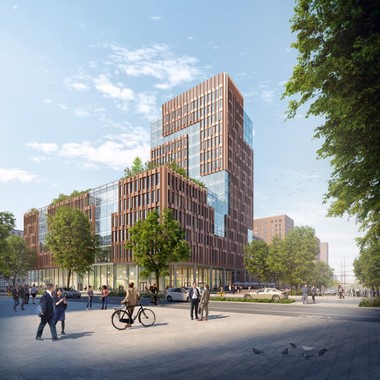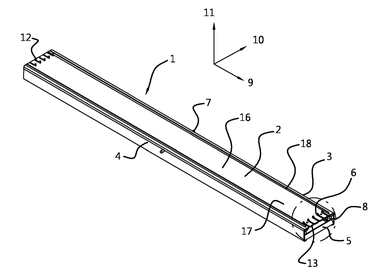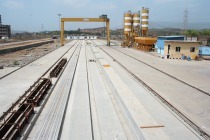Cost-efficient, environmentally friendly construction using prestressed concrete hollowcore slabs
DW Systembau GmbH is a subsidiary of Consolis, a European market leader in precast concrete solutions. Just recently, BFT editor-in-chief Silvio Schade visited the climate-friendly production of Brespa prestressed concrete hollowcore slabs at the DW headquarters in Schneverdingen, Northern Germany.
DW Systembau GmbH is a subsidiary of Consolis SAS, the European market leader in precast concrete solutions employing about 8,800 people and operating 20 companies in 17 countries. In 2021, the group generated 1.1 billion euros in revenue. DW Systembau has been manufacturing Brespa precast prestressed concrete hollowcore slabs in Schneverdingen in the middle of the Lueneburg Heath since 1986.
The business employs about 100 people who produce approximately 400,000 m² of Brespa slabs per year, generating an annual revenue of about 25 million euros. More specifically, about 10,000 m² of prestressed hollowcore slabs consisting of a C45/55 concrete are manufactured in two-shift operation on the sixteen 120 m long production beds each week. After 6 to 7 hours, the floor slabs are cut to size and lifted from the bed.
A major part of the production equipment used at DW Systembau was procured from Finnish supplier Elematic. Concrete is poured using a slipformer (15 to 26.5 cm thick slabs) or in an extrusion process (32 and 40 cm thick slabs).
Outstanding environmental footprint
“Unlike in many other countries in Europe and overseas, cast-in-place concrete and semi-precast slabs are more common in Germany, accounting for about 80% of total project volume,” explains Dipl.-Ing. Architekt Hartmut Fach, Head of Communications at DW Systembau. “Our system makes it possible to build more slender and lightweight load-bearing structures while reducing resource consumption significantly. This translates into 20% lower carbon emissions, 20% lower energy consumption, 50% less concrete and 70% less steel,” Fach continues (for a detailed life-cycle assessment, see the text box below).
Thanks to the distinctive design principle of prestressed hollowcore slabs, the proportion of cavities is around 50% lower than in a full precast slab depending on the geometry, and the amount of steel is up to 85% lower than in non-prestressed reinforced-concrete slabs. In addition, DW Systembau is currently in the process of switching to renewable energies and replacing CEM I cement grades with more environmentally friendly composite cements while retaining the product’s outstanding early strength: The hollowcore slabs are cut to size and lifted from the production bed after 6 to 7 hours. The sand deposits located on the company site also come in handy because they help avoid long transport distances.
Numerous flagship projects
“Our close and fruitful collaboration with Finnish supplier Peikko, for example, enabled us to complete quite a number of showcase projects already,” reports Andreas Zalozynski, Area Sales Manager at DW Systembau. One prominent example is EDGE ElbSide, a striking office building in Hamburg’s HafenCity (see also BFT 10/2021 “Germany’s tallest building in slim-floor design” and BFT 10/2023 “Precast concrete solution instead of timber structure for a new Hamburg landmark”).
Other outstanding projects include, among many other examples, the reconstruction of a temporary courthouse in Enschede in the Netherlands in 2022, which had been deconstructed in Amsterdam in 2016, and a residential complex for students in Bochum-Laerheide, which received the Bochum 2020 Architecture Prize for its sustainable load-bearing structure.
Future aspirations
Even though the crisis in the construction industry means a 40% drop in production and a 15-20% decline in revenue for DW Systembau, the company is making use of this situation to stabilize the business in terms of production and organizational structure at roughly the 2023 level. Supported by sales and marketing, DW Systembau attempts to create the prerequisites to enter a recovery phase as early as 2025, particularly focusing on key issues of the future such as the circular economy, recycling, and carbon emission reductions. More specifically, this includes, among other activities, working on a more climate-friendly production process using different mix designs and longer prestressing changeover times.
Hartmut Fach comments: “Our parent company, Consolis, is already working successfully on processes and types of concrete that aim to reduce carbon emissions. In a pilot project in Finland, for example, a concrete mix design was developed that lowered carbon emissions by 80% compared to the previous level. Also, future capital expenditure in our business will have an even stronger focus on productivity as well as energy and resource efficiency. Finally, we will continue to contribute actively to standardization, research and teaching as well as to improving building regulations through industry associations and organizations.”
CONTACT
DW Systembau GmbH
Stockholmer Str. 1
29640 Schneverdingen/Germany
+49 5193 85-0


